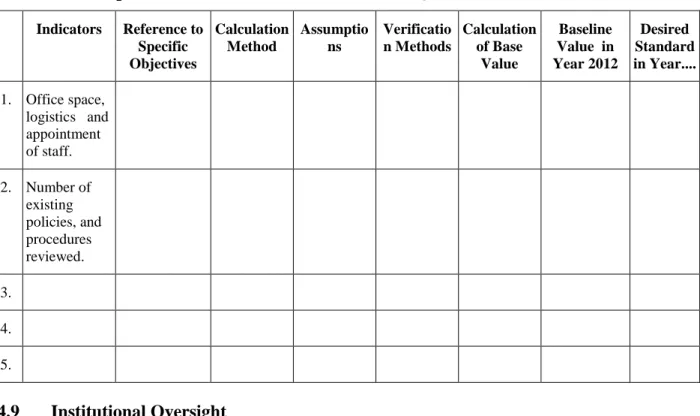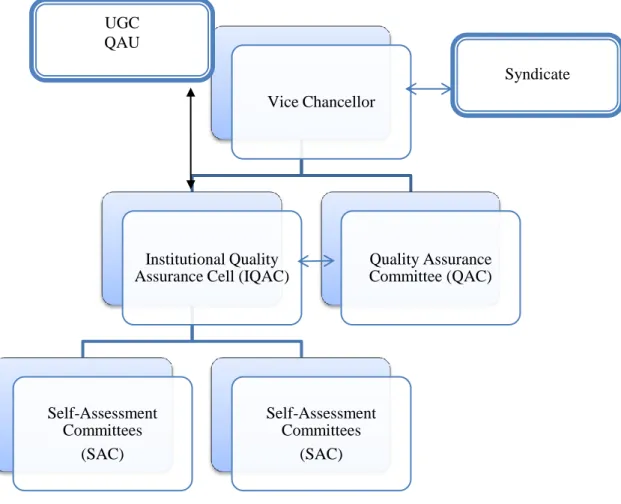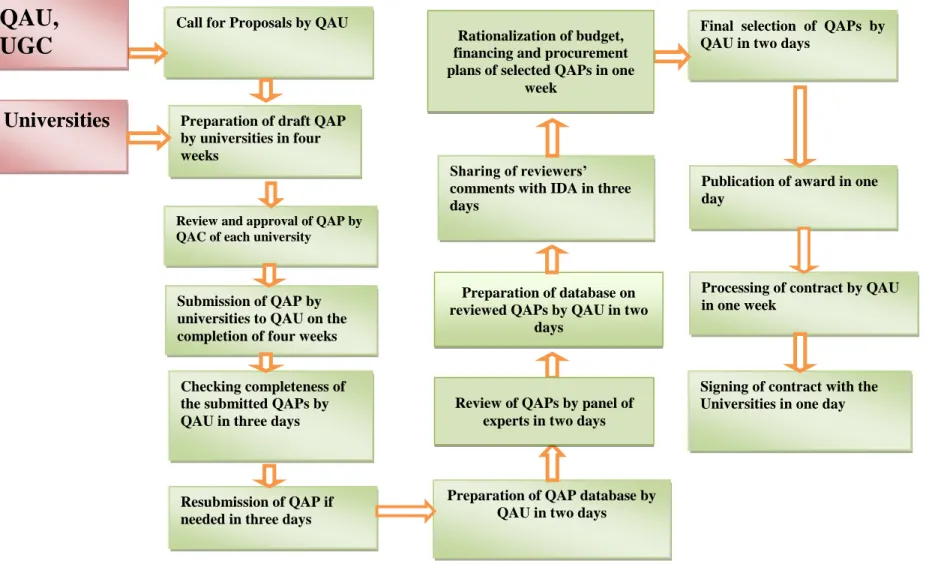These tools and guidelines would facilitate the functioning of Institutional Quality Assurance Cells (IQACs). We hope that the handbook will be very useful to everyone who is directly or indirectly involved in quality assurance in higher education institutions.
The Context
Global Perspective on Quality Assurance
Reasons for Growth of QA Practices
Quality Assurance (QA) Networks
It is an association of more than 200 organizations from 130 countries that are active in the practice of quality assurance in higher education. INQAAHE is a forum for discussion of global issues relating to quality assurance in higher education.
Quality Assurance in Practice
Quality in Education
Quality Assurance System
However, quality assurance systems in higher education consist of two basic components: an internal component and an external component. The internal quality assurance system is made up of the arrangements within the institution to provide the assurance of learning with people's trust.
Quality Assurance Principles
In addition, external quality assurance agency provides feedback and technical support to the HEIs through periodic assessment and validation of internal QA system. It should be noted that external quality assurance does not challenge the practices and autonomy of the internal quality assurance system, but to support by providing guidelines to adopt improved national and international standards of quality assurance practices.
Quality Assurance in Bangladesh
- Urgency for establishing QA Mechanism in Bangladesh
- University Grants Commission (UGC) of Bangladesh
- Quality Assurance Unit (QAU)
- Institutional Quality Assurance Cell (IQAC)
- Salient Features of QA System to be introduced by the QAU
- Future Developments .1 Institutionalization of IQAC
To achieve academic excellence through quality assurance practices in Institutions of Higher Education (HEIs) as a credible and internationally recognized agency. Setting up a quality assurance mechanism at the universities is the first step towards the formation of the proposed Accreditation Council.
Institutional Quality Assurance Cell
- Significance of IQAC
- Establishment of IQAC
- Objectives of the IQAC
- Functions of IQAC
- Composition of IQAC
- Terms of Reference for the Director of IQAC
- Self-Assessment Committee (SAC)
- Performance Indicators
- Institutional Oversight
- The Terms of Reference of the QAC
- The member-secretary of the QAC will serve the notice of the meeting of QAC following Vice Chancellor‟s directive and circulate the minutes
- Functional Relationship of IQAC with QAC and QAU
- The QAC shall act as an advisory body to the IQAC for developing an effective and workable system of quality assurance and oversee the activities of the IQAC;
Each program provider at the university must have a three-member self-evaluation committee. To look after key issues of quality assurance and IQAC activities, a Quality Assurance Committee (QAC) will be established in each university.
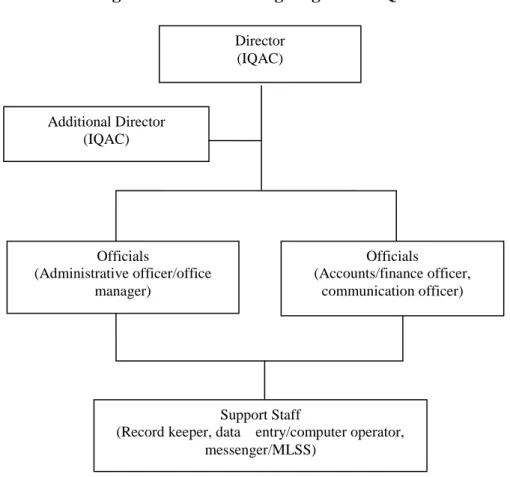
Quality Assurance Framework
Quality Assurance Areas
Quality staff: It must be ensured that the staff of all categories, including academic, support, technical and administrative, are sufficient and skilled to meet the requirements of academic standards and strategies of teaching learning. Appropriate teaching learning methods: Teaching learning method in fact sets the stage for everything in terms of learning outcomes. Use of lesson plan: Use of lesson plan is a growing practice in the teaching of learning internationally.
Integrating technology into teaching and learning will make it much easier and more effective to meaningfully communicate complex ideas and subjects in classrooms. Focus: The teaching of learning in higher education must address the highest order of learning in the educational field, i.e. the application of creativity. Training is very important to increase the professional skills of the staff and to keep them up to date with the best practices in quality assurance.
The university's senior management must be committed to developing a quality culture that recognizes the importance of quality and quality assurance in practice.
Levels of Quality Assurance
Universities will build the required capacity of the IQACs with the guidance and technical support of the QAU to make them functional.
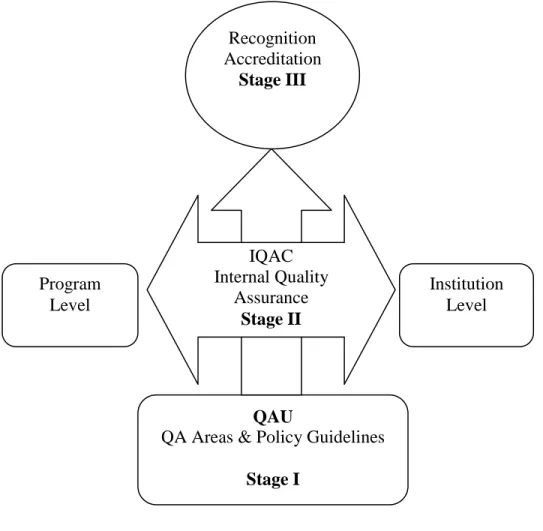
Procedure Design and Review
- Procedures
- Documented Procedure
- Undocumented Procedure
- New Procedures
- The Design Process
The procedure will be signed off by the Head of Faculty or Head of Department who is the procedure owner and endorsed by IQAC. The necessary design and development activities will be carefully considered and put in place to ensure suitability, quality and legitimacy. At the very beginning of the process, apart from needs analysis, it is important to understand the objectives and scope of the new procedure.
An internal faculty/department refers to a faculty or department in the university and external refers to a partner in the case of collaboration between the university and another higher education institution. The need for the procedure is identified by IQAC, or raised by the responsible faculty or department (eg Admissions Office, Examinations Office). The proposal, design and development activities shall be reviewed and approved by the Syndicate for which a brief shall be prepared by IQAC.
If changes are required, the proposal is returned to the concerned faculty/department through IQAC for amendments.
Evaluation and Assessment
Components of Evaluation and Assessment
Director IQAC will place the reports in the QAC meeting and send one copy of the report to the QAU. Nonconformity in system is critical because of the direct consequence of the output. iii). Timeline for the audit exercise from pre-audit planning to the submission of the final report;.
Audit panel members will visit the relevant faculty/entity to conduct the audit exercise as per schedule. Conducting interviews of selected staff and students as necessary for the purpose of the audit; This report will be submitted to IQAC. a) Panel members meet to finalize the report;.
The report must be able to meet the stakeholders' needs and information requirements.
External Quality Assessment and Accreditation
An external report is the result of an assessment carried out by external quality assurance agencies. i) Self-assessment report. IQAC will prepare an Institutional Self-Assessment Report and the entities offering the programs will prepare their own Self-Assessment Reports. A standard self-assessment report should motivate internal QA by identifying its weaknesses and strengths. an internal SA report is prepared for external assessment and informing external assessors about the internal QA system;
- The assessment report will be used as the core document for external peer review. ii) Institutional Quality Assurance Report (IQAR). This report should be prepared by the IQAC to ensure annual monitoring has been carried out. The IQAC submits the report to the Syndicate/Regent Board with the approval of the QAC.
This report is named according to the type of audit performed.
Meta Evaluation By QAU/UGC
Training and Skills Enhancement
Proposal for Training
Internal Training
External Training
Management of Conflicts and Confidentiality
Significance
Officers of IQAC, members of the QA Committee and auditors are committed to identifying and avoiding situations and activities that constitute a conflict of interest in the performance of their duties for the University. Furthermore, activities, situations and relationships that may create the perception of or potential for a conflict of interest will be appropriately identified and managed. The University believes that clear guidelines and principles for reporting and managing actual, potential and perceived conflicts of interest will help staff and students maintain the highest level of integrity in their endeavours.
An actual conflict of interest arises in a situation where financial or other personal considerations compromise an individual's objectivity, professional judgment, professional integrity, and/or ability to perform his or her responsibilities to the University. In addition to situations that clearly give rise to an actual conflict of interest, individuals are cautioned to also consider gray areas that may create the perception of or potential for a conflict of interest.
Management of Confidentiality
Inter-University Council for East Africa, (2010); Handbook for Quality Assurance in Higher Education, Vol – 3, P.8. Quality Assurance and Accreditation Council of Sri Lanka, (QAAC, 2003), Internal Quality Assurance Manual for Sri Lankan Universities, Colombo, P.2. Standards and Guidelines for Quality Assurance in the European Higher Education Area, 3rd edition, Helsinki, at http://www.enqa.eu/pubs.lasso.
European Student Handbook on Quality Assurance in Higher Education, The Quality Assurance and Accreditation Handbook for Higher Education. Zia Batool og Riaz Hussain Qureshi, (Zia og Qureshi), Quality Assurance Manual for Higher Education in Pakistan, Higher Education Commission, Islamabad P.27. Zia Batool og Riaz Hussain Qureshi, (Zia og Qureshi), Quality Assurance Manual for Higher Education in Pakistan, Higher Education Commission, Islamabad P.4.1.
National Quality Assurance and Accreditation Committee (NQAAC). 2004) The Quality Assurance and Accreditation Handbook for Higher Education in Egypt.
Annexes
NEW PROGRAM PROPOSAL FORM
Name of the University) NEW PROGRAM PROPOSAL
- Program Details 8. Program aims
- Fitness of the purposes
- Facilities and Resources 19. Availability of staff
- Endorsement by the Program Offering Entity
- Endorsement by Faculty The Faculty confirms the following
- Endorsement by IQAC The IQAC confirms the following
National relevance (relevance to the goal of the national education policy, socio-economic conditions in the country, etc.)
DOCUMENT CHANGE FORM
IQAC Endorsed by
Basic Information
Professional Information 1. Overall aims of course
- Intended learning outcomes of the course (ILOs) a. Knowledge
- Contents
- Teaching and learning methods a
- Student assessment methods a. Formative
- List of References
STUDENT COURSE EVALUATION FORM
TEMPLATE FOR ANNUAL COURSE REPORTS
Basic Information
Statistical Information
Professional Information 1. Course teaching
- Teaching and learning methods
- Student assessment
- Facilities and teaching materials
- Administrative constraints List any difficulties encountered
- Student evaluation of the course
- Course enhancement
- Action plan for academic year 20XX – 20YY
FACULTY COURSE REVIEW REPORT
To be filled by each teacher at the time of Course Completion)
Comment on the continued relevance of the Curriculum in relation to the intended learning outcomes and its compliance with the National Qualifications Framework.
General rules
Professional Information
- Administration constraints
- Results of course evaluation by students
- External evaluator’ comments
Effectiveness of the overall assessments in measuring the achievement of the intended learning outcomes (ILOs). If there are any shortcomings, identify these, together with any problems with the delivery of the course or the achievement of the ILOs, which resulted. Also mention any management problems or regulations that have hindered the delivery of the course and the achievement of the ILOs.
Include key points arising from the analysis of student evaluation of the course, and the response to any criticism from the faculty members who teach the course, along with their proposals to address these issues. List the issues identified in the previous year's action plan and whether or not they were effectively addressed. It appears at the end of the report because it is the result of all previous analysis.
Also, it clearly places the responsibility for the implementation of the action and the resolution of related issues, in a certain time scale, on the mentioned individuals.
GUIDELINES FOR COMPILING A COURSE SPECIFICATION
- Program Title: Write the title of the program (s) which contain the course, and identify if major/ minor/optional, where relevant
- Year / Level: Write the year and/or level of the students attending the course
- Authorization date of course specification: Write the year in which the course specification has been authorized
- Professional Information
- Course aims
- Intended Learning Outcomes from the course
- Course content: Write in the main course topics, the number of hours allocated for teaching each topic for lectures as well as for seminars, tutorials, exercises, laboratory
- Teaching and learning methods: Identify the methods used in delivering the course such as lectures, discussion sessions, information collection from different sources, practical,
- Student assessment
- List of text books and references
Skills: Skills to be acquired and to be imitated, manipulated, refined, articulated and naturalized by the course. Teaching and learning methods: Identify the methods used in the delivery of the subject such as lectures, discussion sessions, gathering information from various sources, practicals such as lectures, discussion sessions, gathering information from various sources, practicals, research assignments, visits in the field and case. Studies etc. Only formative assessment are those that do not contribute to the overall grading system, but are important in the learning process.
Lecture notes: If notes are available, indicate whether they are prepared in book form authorized by the department or are given to students in parts. When the lecturer uses more than one book that contains parts of the course, list the books and the topics covered by each. The references to be given in the above items must be written in a standard way (publisher, edition, year, author(s) ... etc.).
The facilities include: appropriate teaching accommodation, including teaching aids, laboratories, laboratory equipment, computers, etc., facilities for fieldwork, site visits, etc., necessary for the teaching of the course.
RESEARCH STUDENT PROGRESS REPORT
CONCEPPT NOTE ON SELF-ASSESSMENT
Implementation Phase
External Peer Review and Validation Phase
Improvement Plan
Internal Audit Scale
TEMPLATE OF FACULTY/DEPARTMENT QUALITY ASSURANCE REPORT
QUALITY ASSURANCE REPORT (QAR)
ANNUALINSTITUTIONAL QUALITY ASSURNACE REPORT
ANNUAL INSTUTIONAL QUALITY ASSURANCE REPORT (AIQAR)
DECLARATION OF IDEPENDANCE AND CONFIDENTIALITY FORM
I, (name of member of the audit team), hereby confirm the truth of the above statements and understand that I will be required to cease my current responsibilities if any of the above are found to be untrue.
TEACHER EVALUATION FORM (To be filled by the student)
CLASS ROOM TEACHING OBSERVTION REPORT FORMAT (To be filled by the peer observer in class)
General Information 1. Name of the program
Aspects Evaluated and Scoring Scale (Please circle the score for each aspect)
- Presentation
Observer’s Overall Comments and Suggestions for Improvement
Presenter’s Comment/Remarks
Signatures
SURVEY FORM FOR PhD PROGRAMSOFFERING ENTITY
16 years equivalent) courses required for PhD 5.5 Total number of MPhil level courses taught on average in a semester/semester.
QAU, UGC
Universities
QAACB
IQAC
QAU Programs
Program Accreditation
Quality Management at
